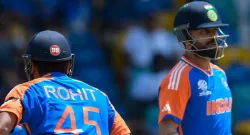
Picture Credit: ICC
2017 was, in some ways, a landmark year for international sports where several key faces carved a unique place for themselves under the sun. It was a terrific year year for Christiano Ronaldo as he won a plethora of trophies, including La Liga, Champion’s League, Super Cup, Supercopa, while the great Messi got his hands on the Copa Del Rey. In Formula 1, Lewis Hamilton overcame a title-threat from arch-rival Sebastian Vettel in garnering a fourth world title, with Mercedes winning the Constructor’s championship yet again. But with no dearth of record-shattering action, a close-knit group of women from India were forging their own glorious chapter in cricket, miles away from the sub-continental conditions, unbeknownst to even their own selves about the glorious mountain they were about to scale. Among this group was a batswoman of redoubtable caliber with the bat, a woman who today has become the captain of the ship. But back then, it was her voyage to glory at the pinnacle of cricket, the 2017 Women’s World Cup, held in England, and during an epochal moment, the semi-finals, she brought India home safely amid a violent sea of trouble called Australia. Truth be told, there’ll always be talents who come and score mind-boggling hundreds, some will score a 250 before lunch and some will actually go on to strike T20 cricket’s first double century; but not everyday shall we see a batter go on to craft a century so definitive that would mark a revolution of sorts.
In a sport where the iconic Rachael Heyhoe-Flint marked the beginnings of the women’s World Cup, and where the great Meg Lanning has scored 14 centuries in ODIs, where Amy Satterthwaite scored four consecutive ODI centuries, Harmanpreet hammered a 171 and in the process of doing so, remained at the crease until the end.
That her personal best also happened to be highest score for India as well as the highest-individual score by any batter in World Cup history marked the occasion as an epochal moment in the firmament in women’s cricket.
Moreover, that Harmanpreet Kaur’s best yielded a big win for India, charting the course for the team’s entry into the final, went a big way in opening those eyes toward women’s cricket for whom the sport’s meaning was sadly, only restricted to the men’s game.
To this day, the milestone knock that came off of just 115 deliveries is seen as a pleasant shocker of sorts that got a Virat Kohli and Sachin Tendulkar-obsessed India to wake up from its slumber in its acknowledgment of the fact that our girls from India too could do great things.
Harmanpreet's masterclass against strong Aussie attack
And it was on July 20, 2017, against an Australian attack powered by the great Ellyse Perry, Kristen Beams, Megan Schutt that Harmanpreet lifted India to the path of glory, appearing less of a batswoman to the Aussies and more as a hurricane that consumed everything in its wake during a 143-minute mesmerizing stay at the crease.
Well, mesmerizing only to the Indian contingent but devastating to those Australian fans who couldn't have imagined that a side made up of the great Meg Lanning, Ellyse Perry, Alex Blackwell, Elyse Villani, Ashleigh Gardner and Beth Mooney would find themselves cornered in a dead-end.
Though, long before the century came into being, India’s start was terrible to say the least. In a game where much was expected of Smriti Mandhana, who had fired a marvelous 106* in the same tournament (earlier) vs the West Indies, one saw the dangerous left-hander return to the pavilion for just 6.
Poonam Raut, otherwise reliable and experienced, would last for just 26 deliveries, before walking back for an ordinary 14, India 2 down for 35 in ten overs.
That is when an innings-reviving stand would take centerfold, Mithali Raj, accumulating 36 useful runs, with Harmanpreet Kaur firmly stationed at the other end.
But at the halfway stage when Mithali was sent packing by one of Australia’s most prolific spinners, Beams cleaning up the stumps, in walked Deepti Sharma, and it was almost a role reversal of sorts.
Harmanpreet, until such time, more subtle and defensive, would become the aggressor and shed the skin of the preserver, becoming an attacker who would change gears, Deepti, meanwhile, became the careful accumulator.
That is when the Aussies began to sense that something precarious was about to unfold as Harmanpreet Kaur began to dance down the track and lifted the spinners effortlessly over long on and covers for towering hits.
Facing a free-hit off Beams in the 27th over, Harmanpreet danced down the track like a ballerina on a glitzy stage and lifted the leg-spinner to a 90 meter six over deep mid wicket.
But that was just the beginning of the carnage.
The medium-pacers found no respite whatsoever. One of the shots in Harmanpreet’s defiant 171 would be the extra cover drive off Villani.
Brutal to anything bowled short and around the legs, she whipped Perry in the 31st over to power a pull on the mid-wicket region. At that time, Punjab’s finest export to women’s cricket had already completed her fifty.
Playing akin to a batsman who, it seemed, had one shot at glory, absolutely unafraid to expose the off stump, as she jumped, hopped, pulled and swiveled in exploring all sides of the Derby ground, the right handed batter’s show soon became Harmanpreet versus Australia.
Her century came after a quick double taken off Beams in the 35th over, immediately after which she’d change gears, becoming even more dangerous than before, as if the demon inside her was prepared to put the Australians to the sword.
Among the definitive sights in that mowing down of Australians were the consecutive sixes fired over mid-wicket off Gardner in the 37th over, which would be immediately followed by a gorgeous cover drive. The crowd, by then, became easily aware that they were witnessing history being made.
21 came off a punishing over of Gardner!
A slower, flighted delivery, the very next over by Villani got the treatment as Harmanpreet bent down on her knees to send the white-ball for a flat six. Then, by the time the 40th over arrived, Harmanpreet was just 1 away from a 150, a score perhaps none would’ve imagined having seen India reeling at 2 for 35!
She’d soon clip one bowled on the legs by Perry for a quick single to notch up her 150. By this time, Veda had arrived.
A few overs later, the crowd would see skywards as Harman powered the longest six of the match in her favourite deep mid wicket region, sending Beams’s loosener way into the stands.
This was destruction at its overpowering best. A sight to behold. In the final over of India’s innings, the match reduced to 42 overs apiece, a glorious square cut off Schutt took the belligerent hitter to 169, before she’d go on to collect another two to move to 171.
During her reign at the crease, having walked in the tenth over, many batters came and went, but on July 20, Harmanpreet remained the immovable force at the crease.
At the end, it was a mighty brave knock, an inning constructed amid pressure with just one aim above anything- to fight for India’s glory.
Frankly, in the last half a decade since her 171*, none have gone on to fire another belter of a knock of the highest class and bravado, which only prompts a question- can she do it again and maybe, go even bigger come the next Women’s ODI World Cup?




